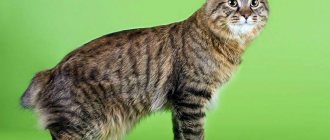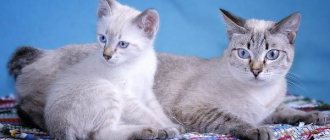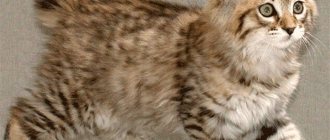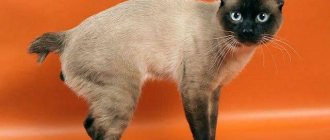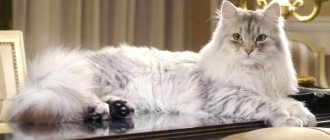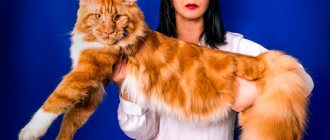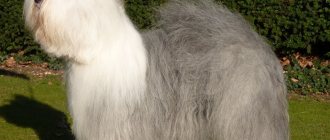The Kurilian Bobtail is an interesting representative of the cat family. Due to its size and habits, it has taken root well in rural areas. It’s difficult to call her sweet and gentle; many of her character traits suggest that she is a dog in cat’s clothing. You shouldn’t make a fuss towards the bobtail; you’ll be ignored – call him by name.
Such habits are sure to endear dog lovers who do not like the amount of attention that a dog usually needs. Of course, a cat can be raised to be affectionate and gentle, but it is difficult to perceive the Kuril Bobtail as a sissy.
The Soviet Union is considered the birthplace of the breed - it was thanks to Soviet felinologists that the cat came to the mainland and received recognition. At the same time, there is reason to believe that the breed is more than 200 years old, and it originated, then, on the Japanese islands.
Origin story
Among the ancestors of the Kuril Bobtail are the famous Japanese Bobtail: stately and strong cats with the same short tails and a “dancing” gait. The Japanese kept these animals in temples and revered them as sacred objects, but the craving for a free life often took precedence over their usual comfort, and the cats ran away into the wild.
Once on the Kuril Islands, Japanese bobtails began to change noticeably: the cats increased in size, their coat color changed, and their claws stopped retracting inward. And over time, when Russian settlers brought their favorites to the islands - wonderful fluffy Siberian cats - they became friends with them.
As a result of the mixing of blood, the modern Kurilian Bobtail was born - an outstandingly sized cat with thick dense hair and a funny pom-pom tail. Their amazing agility, unfailing hunting instinct and good health captivated people and in the late 80s, cat lovers started talking about them as a full-fledged breed. The first standard was adopted by the Soviet Felinological Federation in 1991, the general one (WCF) - in 1995.
Today it is not difficult to buy a Kurilian Bobtail kitten. There are quite a lot of nurseries operating in Russia, and there is no shortage of private breeders. The cost depends not only on the appearance, but also on the titles of the parents, the conditions of keeping and raising the animal. The price tag starts from 20,000 rubles. Taking an animal from your hands and without documents is fraught with problems in the future.
How much does a Kurilian Bobtail cost?
As with other breeds, the ideal place to purchase a Kurilian Bobtail is in nurseries that specialize in breeding this breed. The price of an adorable baby starts from 8,000 rubles; the upper limit is limited to 20,000 - 25,000 rubles. In general, the cost of a bobtail is determined by the prestige of the nursery, the presence of a noble pedigree and the class of the kitten (show, breed or pet).
It is worth noting that this breed also has a fourth class - “novice”. It consists of individuals brought directly from the Kuril Islands. The origin of these animals is unknown, but if it is not important for you to become the owner of a pet with noble ancestors, go for it! In any case, the Kurilian Bobtail will become a devoted friend and companion.
Standards
| Standard | Description |
| Eyes | Rough, large and expressive. The iris can be any (snow-white cats have both blue and multi-colored eyes). |
| Head | Large, with smooth, rounded contours, wedge-shaped. The ears are small, with a wide base and rounded tips. They are slightly inclined forward and are equipped with tassels like those of a lynx. The whisker pads are plump and well expressed. The nose is of medium size, wide, level and straight. The chin is clearly defined, massive, with rounded edges. |
| Torso | The body is powerful, long, with developed muscles and strong bones. The hips are raised, the chest is wide. The limbs are not short, but they cannot be called long either. Powerful and strong. Paws are oval, large, spread out. |
| Tail | The tail is a distinctive feature of the Kurilian Bobtail. Outwardly it looks like a soft fluffy pompom. The length can be different: in cats with semi-long hair - 11-13 cm, with short hair - 1.5-8 cm. There is an undercoat, but it is quite small. |
| Wool | The coat can be semi-long or short. Bobtails with short hair have the same length all over their body. Cats with semi-long hair always have a fluffy collar, “pants” on the hind legs, socks and a plume on the tail. |
Felinologists distinguish 4 types of tails:
- Longest: includes 5-7 vertebrae. At first they form a straight line, and then twist into a loop. But such a tail is considered a serious drawback.
- Tail-broom: here there can be even more vertebrae - 8 or even 10. But the tail remains straight.
- Spiral tail: Also 5-10 vertebrae forming a small hook or spiral.
- The last and shortest tail is a stump. Consists of a minimum of 2 and a maximum of 8 vertebrae that are seriously deformed.
Characteristics of Kurils
It turned out that the Kuril Bobtail combines the character qualities of both a wild ancestor and a domestic cat. But there is no clear line between these features.
This is a friendly, trusting cat
. He easily finds a common language not only with his owner, but also with other cats and dogs. The Bobtail is smart and intelligent. Therefore, if he misbehaves or is drawn to dangerous adventures, it will be enough to have an educational conversation with the pet. Kuril cats can easily tolerate long trips, changes in environment, and interactions with small children.
In addition, short-tailed cats are active and inquisitive animals.
. Their potential is revealed in all its glory in nature. They love to explore open areas, climb trees and fight with neighbor's pets for territory. Breed experts say that bobtails love water and are excellent swimmers. Therefore, you should not be surprised if one day he brings freshly caught fish into the house.
Another important facet of the Kuril Bobtail’s is that it is an intelligent and tireless hunter.
. If a representative of the described breed lives in the house, it means that the person is not at risk of rodent infestation. They say that in nature the catfish catches squirrels, hares and snakes. At the same time, when kittens appear, even stern bobtail cats become gentle and caring parents to their children.
The breed is distinguished by high levels of intelligence. Therefore, you will not have any special problems in training your pet. Kittens are easy to raise and litter box trained.
Weight table by month
The weight of an adult Kuril Bobtail reaches 4-7 kg, in cats - 5-9 kg.
| Age | Cat | Cat |
| 1 month | 280-400 gr | 330-460 gr |
| 2 | 550-750 gr | 880-1.2 kg |
| 3 | 1-1.2 kg | 1.1-2.2 kg |
| 4 | 1.3-2.4 kg | 1.8-3.2 |
| 5 | 1.7-2.7 kg | 2.6-3.6 |
| 6 | 2.6-3.4 kg | 3-4.4 kg |
| 8 | 3-4.1 kg | 4-5.2 kg |
| 10 | 3.2-4.4 kg | 4.4-5.8 kg |
| 1 year | 3.5-5 kg | 5-6.8 kg |
| 2 | 3.8-6 kg | 5.4-6.6 kg |
How to choose the right kitten
The first thing you need to understand is the purpose for which a purebred kitten is purchased: for breeding, an exhibition career, or just for fun. The cost of the animal will depend on this. In any case, it doesn’t hurt to collect the most complete information about the bobtail breed.
In order not to make a mistake when choosing a kitten, you should adhere to the following principles:
- the age of the purchased animal must be at least 2.5 months;
- You can only buy a pet from trusted bobtail breeders;
- a breed certificate is required;
- the animal must have the necessary vaccinations;
- When purchasing, you should check for the presence of standard breed characteristics;
- the kitten should be active, playful, with a good appetite.
The future owner of a purebred animal should understand the responsibility that he assumes. Regardless of the purpose for which a cat is purchased - for breeding work to maintain the purity of the breed or an exhibition career - it requires, first of all, love and care.
Kitten care
To keep your cat healthy for many years, you need to take care of her from an early age and follow the rules:
- the animal must be litter trained. By the time of purchase, all bobtail babies already know how to use the litter box. The contents of the tray should be changed regularly;
- The baby's diet should be varied. There is a large selection of special foods for kittens; choosing a suitable diet will not be difficult;
- Dishes should be kept clean;
- in the first year of life, kittens are not bathed unless absolutely necessary;
- at the age of 3 months, animals are given the first anthelmintic prophylaxis; it is repeated every 3-6 months;
- it is necessary to “make friends” of pets with a comb. The combing procedure should be enjoyable for the kitten;
- The animal should be accustomed to the scratching post. Then the furniture in the house will be in order;
- You need to examine the kitten’s ears once a week;
- there should be no small objects on the floor, shelves and other accessible surfaces. The baby may choke on them;
- it is necessary to remove all wires from electrical appliances;
- The kitten should not be allowed to go out onto open balconies and windows.
Kittens eat little but often. To prevent them from starving, bobtail breeders recommend leaving food, water and milk out overnight.
Colors
Colors are varied, but certain colors are prohibited in most show systems: fawn, lilac, chocolate, cinnamon, acromelanic (Tonky, Siamese and Burmese) and ticked colors.
The amber color was discovered only recently and has not yet been included in the general standard.
Acceptable colors:
- Tortoiseshell and solid (black, red, cream, blue, white);
- Tabby;
- Marble (red, black, blue, cream, tortoiseshell);
- Brindle (black, red, tortoiseshell, cream, blue);
- Spotted (red, black, blue, cream, tortoiseshell);
- Harlequin (including marble);
- Bicolor;
- Wang;
- With white spots.
In the photo there are cats of the Kuril Bobtail breed of popular colors: black, white, tortoiseshell
Key facts
The main characteristic of the Kurilian Bobtail is its tail. Outwardly, it resembles a fur ball. This trait was inherited by the breed from its Japanese neighbors.
Despite the fact that cats are proud creatures by nature, they are seriously attached to the family in which they live, but they can only have one owner. Do not pay attention to the similarity of these cats with wild predators. They are friendly and playful by nature.
Bobtails will only be welcome for children in the house. Don't want your child to be bored alone? The Kurilian Bobtail cat will take part in any game. Bobtails also treat other pets leniently, however, given their cat-like nature, you should still not let ornamental birds or rodents get close to them.
Be prepared for the fact that from time to time the bobtail will test your nerves and show excessive nobility and willfulness. Do not succumb to the furry's provocations, otherwise he will lose respect for you. The description of the Kuril Bobtail breed explains its dominance by the conditions in which the breed was bred.
The health and life expectancy of the Kuril Bobtail are encouraging: seals live up to 15 years, and there are also those individuals that have reached the 17-18 year mark.
Character and behavior
The Kurilian Bobtail is often compared to a dog, which is not surprising: in devotion to humans, this cat breed rivals all those you know. These cats are calm, affectionate and gentle creatures who, however, can quite stand up for themselves. People are adored and immediately upon arriving in a new home, they choose a leader, whom I will follow through thick and thin.
Your movements around the apartment will not go unnoticed: bobtails will follow you on your heels, trying to show you their devotion and readiness to help in business. Even if such obsession annoys you, you will have to come to terms with it: bobtails have curiosity and a desire to be in company until they are very old.
He gets along with other pets without problems, but this applies exclusively to dogs and cats. Small animals (birds, hamsters, rats, chinchillas) are potential prey for bobtails, which they will chase until they catch them.
Other family members are potential friends for the bobtail. Cats treat children very kindly, carefully and patiently. They will not allow themselves to let out their claws or bite a child, so do not worry about leaving your Kurilian Bobtail and your toddler alone.
What does this pose mean in cats: crouching to the ground, arching their back, starting a mournful song?
Mating gamesPreparing for a fight
Character of the Kurilian Bobtail
In contrast to the external resemblance to a wild and unapproachable lynx, representatives of the breed are distinguished by genuine friendliness and affability. This significantly speeds up the bond between cats and new owners. The Kurilian Bobtail will not sit, frowning, under the chest of drawers and snort irritably in response to your attempts to get it out of its temporary hiding place. On the contrary: these animals love to communicate and actively get involved in joint games with family members. “Kurilians” are often called dogs in a cat’s body, since they happily bring toys and balls thrown by the deft hand of the owner.
By the way, the Kuril Bobtail develops a very tender relationship with its family. For representatives of this breed, there is nothing more important than loved ones who give them sincere love and care. The animal will protect the family in which it lives exclusively “like a dog”: taking a menacing stance and meowing in warning. At the same time, the bobtail will especially take care of one person, whom he considers his master. If you managed to occupy this honorable pedestal in the furry guard’s heart, the pet will follow on your heels, communicating in its own language and taking all possible part in your life.
Kurilian Bobtails are ideal for families with children. An animal will never intentionally scratch a baby, but, on the contrary, will bestow excessive “mustached” care on him. The “Kurilets” will not show aggression even if a child accidentally pulls its tail or ear. Instead of hissing and being offended all day long, a bobtail will happily involve your child in a game of hide and seek or demonstrate a recently learned trick that will certainly cause sincere children's laughter.
Representatives of the breed get along well with other pets. Cat or dog – it doesn’t matter: the Kurilian Bobtail will find a common language with both the serious Maine Coon and the playful Dachshund. However, it is strictly not recommended to keep ornamental birds and rodents in the same house as a bobtail. A hunting instinct that awakens at the wrong time can turn into a tragedy, and your attachment to an animal can turn into grief for a lost feathered or furry friend.
Along with being meek and good-natured, this breed is distinguished by its willful and independent character - this is what many owners of Kuril Bobtails say. Animals do not like to sit in your arms for a long time, pretending to be a plush toy, and will soon try to leave the heated place. In the absence of proper attention from the owner, the “smokers” begin to live by their own rules and soon consider themselves the rightful owners of the territory, namely your apartments. At the same time, overthrowing the short-tailed usurper will not be easy. Even the slightest glimmer of success will soon turn into defeat for you: the pet will begin to protest. Damaged things, torn blinds or curtains, an overturned sugar bowl - and the Kurilian Bobtail’s vendetta will not be limited to this.
Do you think that your pet is overly lazy and less and less involved in games? Take a day off from work and go with your animal to the country, where it will appear before you in a completely different form. A dexterous hunter will in the blink of an eye displace the domestic bumpkin from the Kuril Bobtail. In the fresh air, representatives of the breed are especially active: they track prey for several hours without closing their eyes; fight with neighbor cats for free territory; they poke their curious nose into every remote corner of the house, emitting a purring sound reminiscent of bird trills.
Care instructions
Wool
The Kurilian Bobtail's coat does not tangle and is not prone to tangles, so you should not brush them more than 1-2 times a week. These cats simply love to swim (by the way, Kurilian Bobtails are not only good hunters, but also excellent fishermen), so bathe them once every 1-2 months.
Claws
They get accustomed to the scratching post quickly and do not need additional nail trimming.
Eyes
But you need to watch your eyes and ears. Both are wiped with a damp cotton pad soaked in hydrogen peroxide, tea leaves or chlorhexidine.
Teeth
Teeth are brushed 2-4 times a week using a special toothbrush with soft bristles and cat toothpaste (Bars, Doctor ZOO).
In the photo there are cats of the Kuril Bobtail breed: short-haired and semi-long-haired
Education and training
Kurilian bobtails have developed intelligence, which allows animals to understand the meaning of over a thousand words! Raising a pet is not difficult: the main thing is to correctly determine the boundaries of what is acceptable. You should not raise your hand to the cat, because there are other ways to tell your pet about your dissatisfaction. A stern tone is quite enough. This tactic also works if you want to stop your bobtail from acting inappropriately. The word “no” will certainly prevent unwanted consequences.
If your pet has escaped your close attention and misbehaved, have an educational conversation as soon as possible. Otherwise, the bobtail will not understand what exactly he has done wrong.
Upon reaching a certain age, “smokers” begin to test the owner’s strength, making attempts to take a leading position in the house. At this stage of education, you will need to be able to adequately respond to the animal’s behavior and make it clear that you do not plan to cede dominance to your wayward furry friend.
Otherwise, raising Kurilian Bobtails is not difficult, especially for people with a strong character. Teaching your pets to use the tray and scratching post for their intended purpose is also not difficult.
Representatives of this breed are easy to train. Their inquisitive mind allows them to learn new tricks and adopt the skills of their tailed brothers. Turn the training process into an exciting game - and soon your bobtail will delight you with brilliant execution of commands!
Catering
High-quality food for the Kuril Bobtail is the key to a long and healthy life. So remember:
- An adult animal is fed 2 times a day: in the mornings and evenings. You should wash the bowls once a day (do not use any detergents other than laundry soap) and pour clean water at a comfortable temperature into the drinking bowl every day. Kittens 2-5 months old are fed 3-6 times.
- Don't feed your cat from your table. Fatty soups, fried potatoes, chocolate and other favorite foods, unfortunately, are real poison for the animal. Sweet, salty, smoked, sour, canned, flour and baked goods are strictly prohibited.
Natural products
Important diet foods:
- Meat (beef, chicken, turkey, rabbit).
- Fish (both river and sea).
- Plant foods (zucchini, pumpkin, carrots, green salad, asparagus, broccoli, parsley, dill, beans).
- Chicken yolk (boiled), quail eggs.
- Porridge (rice, oatmeal, buckwheat, millet).
- By-products (liver, kidneys, ventricles, hearts).
- Dairy products cause metabolic disruption. The same applies to potatoes, baked goods, dog food, and human canned food. But sprouted oat grains for bobtails are one of their favorite treats.
The water should either be passed through a kitchen filter or left for a day in an open container.
Recommended food
When choosing dry food, buy only food from the holistic group. Applaws, Farmina N&D, Jaguar. Other foods are not suitable for Kurilian Bobtails.
Below are the recommended holistic class foods. Links with the names of the food are clickable, on them you can, within our website, get acquainted with the descriptions of the food and read reviews from owners of Kuril Bobtail cats.
| Holistic | Holistic | Super premium |
| Acana | Go Natural | Organix |
Castration and sterilization
Animals that do not meet standard breed characteristics and are unsuitable for breeding must be spayed or neutered to avoid unwanted matings.
At what age is it recommended to have surgery?
Castration or sterilization surgery is performed:
- for females - at 8–12 months (preferably before two years);
- for males - after 10 months.
The younger the animal, the easier it will tolerate surgery and anesthesia. Too early surgery can lead to delayed development of the animal.
Caring for your pet after surgery
Proper care of your pet after sterilization or castration surgery involves the following measures:
- immediately after the completion of surgical procedures, a special postoperative blanket and an “Elizabethan” collar are put on the animal to prevent sutures from licking;
- providing the pet with peace and quiet;
- daily treatment of postoperative sutures with disinfectant solutions (hydrogen peroxide, chlorhexidine, etc.);
- After the operation, the animal cannot be fed for 10–12 hours;
- limiting the pet's activity to avoid damage to the sutures.
After spaying or neutering surgery, it is necessary to put a post-operative blanket and collar on your pet.
If any negative symptoms are observed (wetting or suppuration of the sutures, lack of appetite for three days, etc.), then you should contact a veterinary clinic for advice.
All cats react differently to anesthesia. Some come to their senses almost immediately, while others sleep for a very long time. Our cat moved only along the wall for more than a day; she swayed in all directions. She started eating on the third day, but she returned to normal only a week later, when the blanket was removed.
Diseases
The immunity of cats of this breed is enviable. But they also have weaknesses.
The first thing you should pay attention to is the ponytail, or more precisely, the area under it. At the very first inspection, find out whether there are any cracks, irritation or ulcers. Such a short length is a prerequisite for the occurrence of an inflammatory process or prolapse of the anus. The Kurilian Bobtail should be examined regularly, and if damage is found, take it to a veterinarian for examination. Remember: if you feed your cat poorly, he will develop this kind of illness quickly.
Ordinary sea buckthorn oil helps to deal with small cracks: they lubricate the anus area with it and make sure that the cat does not lick it right away.
The second nuance: in Kuril Bobtails, the urine pH is significantly different from the urine of cats of other breeds (7-7.5 versus the usual 6-6.5). Therefore, they rarely suffer from urolithiasis of the alkaline type.
Timely and regular vaccination will help protect your pet from a number of diseases - rabies, rhinotracheitis, panleukopenia, calicivirus, leukemia, peritonitis. The kitten receives its first vaccinations at the nursery, but in the future you will have to learn the vaccination calendar and take your pet to the doctor yourself.
Information about the procedures is entered into the veterinary passport. You should not vaccinate yourself (if you do not have the appropriate education: a mistake can lead to serious consequences. Do not try to vaccinate your pet against all diseases at once: this is too much stress on the immune system!
Health and disease of the Kurilian Bobtail
From their Siberian ancestors, cats inherited good health, which rarely causes unnecessary trouble for their owners. There are no specific or genetic diseases observed in this breed, but certain diseases are still common among Kuril Bobtails. Among them:
- cracks and inflammation of the anal mucosa;
- rectal prolapse;
- urolithiasis disease;
- haemorrhoids.
The excellent immunity of animals does not exclude the possibility of developing infectious and parasitic diseases. Regular vaccinations and visits to the veterinary clinic are a guarantee of the health and longevity of your pet.
Advantages and disadvantages
- They are not afraid of water.
- Good hunters.
- They don't mark their territory.
- They know how to warn about dangers.
- They learn quickly.
- Friendly.
- Devotees.
- They have good health.
- They love to talk.
- They can be intrusive.
- Loneliness is difficult to bear.
- They do not like to sit on their laps or hands.
- Bobtails often have problems with the toilet and anus.
- Demanding something, they howl unpleasantly and frighteningly.
Vaccinations and antiparasitic treatments
Despite a cat's typically reclusive lifestyle, vaccinations are necessary to keep her healthy. The first vaccination is given at 2-3 months of age. Then repeat every year at the same time.
10 days before the procedure, anthelmintic and antiparasitic (fleas, ticks) treatment must be carried out. The veterinarian selects anti-helminth medications and vaccines.
It is not recommended to vaccinate pregnant cats and kittens during the teething period. After vaccination, the pet requires a more attentive attitude towards itself, because it may become unwell. At this time, contact with other animals should not be allowed.
Following the vaccination schedule will help maintain health and prolong the life of your pet. The lifespan of a Kuril cat is from 12 to 18 years.
Tips for choosing a kitten
Purchasing a kitten of this breed is a responsible step. Carefully study all the kittens in the litter and choose the one that suits you best. Neither your friends nor the breeder will help you in this matter, so you should not listen to their words. They cannot know what kind of pet you need.
You should buy a kitten at about three months of age. At this age, the bobtail is already learning to be independent and not dependent on its mother. The kitten’s psyche is sufficiently developed to adapt to new conditions and owners.
If the pedigree of your future pet is important to you, ask the breeder for documents, achievements, and certificates. It would also be a good idea to meet the parents in person. If the breeder is silent and does not express a desire to fully answer your questions, this is a sign that he has something to hide.
Pay attention to the kitten's behavior among its siblings. If he actively plays with them and shows genuine interest in you, then you can be sure that this is your baby. Lethargic or timid Kurilian Bobtail kittens may grow up hysterical and unsociable in the future.
Features of feeding and diet
Bobtails are completely unpretentious in food. But you shouldn’t feed him table scraps either. For a cat who regularly participates in exhibitions, the best food will be premium food. If your pet does not win medals and titles, regular food with the addition of boiled meat and vegetables will do.
There are several things that you should not feed to a representative of this breed:
- eggplants, potatoes, any legumes;
- fish;
- sweets;
- raw or fried meat;
- dairy products;
- fatty meat (pork, lamb).
You can give your pet water. If you use tap water, it needs to sit for at least 24 hours.
Breeding and breeding
Individuals that have reached a certain age are suitable for breeding. Males are given for mating after 12 months, and for females the age of first mating is 1 year and a month, but experienced owners advise mating a girl for the first time every two years.
Mating partners must meet the following requirements:
- Lack of closely related ties.
- The coat is the same length.
- Health.
- The tail meets breed standards.
For mating, the cat is brought to the cat's territory.
For mating, the cat is brought to the cat's territory. Mating period is 2-3 days after the onset of estrus. Pregnancy lasts 58-72 days.
Types of bobtail cats
The types of bobtails that are known today began naturally at different times. The photo shows the main varieties of bobtail cats:
American, bred by felinologists in the early 80s. It took two decades to create this variety. Features include striped color, large size, and “knots” of the tail.
Karelian, thick coat with undercoat, close-set eyes, varied color except spots. A successful hunter, a loyal friend, behavior close to that of a dog.
The Kamchatka bobtail cat may have evolved from the Japanese bobtail. Luxurious fur, round eyes.
Mekong, bred in Thailand. Features: small size, characteristic “Siamese” color, slanting blue eyes. Capable of protecting the house like watchdogs.
Manx, a British variety of almost tailless cat, is large, weighing up to 7 kg. The coat is thick and striped in color. The eyes are large and round, creating a surprised look.
The pixie bob, a smaller version of the natural lynx, has a short tail and up to 7 toes on the hind feet, common in Canada and the United States.
Japanese, known since the 16th century, the breed was recognized in 1993. Small specimens weigh up to 4 kg, with a curved tail. The color is white, with black or red spots. The eyes are slanted, wide open, often of different colors.
Interesting facts about the bobtail breed
Bobtails are like dogs when they wag their short tail to express their happiness.
The difference in the length of the front and hind legs and the short tail make bobtails funny, sometimes they can't keep their balance and just flop down on the floor.
The desire to imitate the owner brings the intonation of the cat’s meow to perfection; it can begin to “talk” to the owner.
Bobtail breed temperament
Bobtails are called cute, affectionate and obedient. These pets make excellent companions. They are not aggressive and get along well with children, older people and cat-friendly playmates.
Although this breed is playful, it is not very energetic. You can expect them to want to play every day, but only a little, otherwise they are ready to lie around and snuggle with their owner all day long. Lie by the laptop on the table while the owner types texts, keep your paw on the mouse and try to help your beloved.
True to their laid-back nature, these cats don't have super voices. The Bobtail will make noise when necessary, but you will hear more chirps and trills from it than a full-fledged meow. Attentive to the owner’s speech, the cat tries to repeat the intonation, which is sometimes quite funny.
The main characteristic of a bobtail cat is absolute affection. More than anything else, a bobtail wants to love—and receive that love! If you need a good companion pet, then this breed is suitable.
Gentle felines with short pom-pom tails are ideal for families and are sometimes offered as therapy animals to neurotics.
Mekong (Thai) Bobtail
The Mekong Bobtail (the old name of the Thai Bobtail breed) is a cat whose origin is covered in the legend of the sacred Thai animal. These cats existed back in the days when countless and innumerable treasures were kept in the Buddhist temples of Ancient Siam. These cats guarded the Siamese princesses, accompanying the beauties everywhere. While bathing, Thai high-ranking girls took off their jewelry and hung their guard cats on the broken and twisted short tails, from which they could not fall and get lost.
Mekong Bobtail cats resemble their Siamese friends: the same wedge-shaped head, only with rounded shapes, the same slanting large almond-shaped eyes of a piercing blue color. And, most importantly, it is a unique color-point color of various species.
The hind legs of this type of bobtail have a distinctive feature - the claws on them do not retract inside the pads, so a light tapping sound is heard when walking.
A characteristic behavioral feature of the Mekong Bobtail is a clear imitation of dog manners. This doesn't just show up in games. During a walk, the cat will behave completely like a dog: walk next to the owner, demonstrating complete obedience, and in case of danger, he will certainly rush at the offender.
But during the breeding and raising of offspring, an amazing distribution of responsibilities will be observed, not typical of other breeds. After giving birth to kittens, a bobtail cat feeds the babies and minimally cares for them. But the cat takes on the main functions of raising the heirs: he licks them, teaches them all sorts of wisdom and behaves like a real father of the family. In addition, the Mekong Bobtail cat, having created a family with a cat, behaves completely atypically for cats; he remains faithful to his cat, unless a person forces him to mate with another partner.
